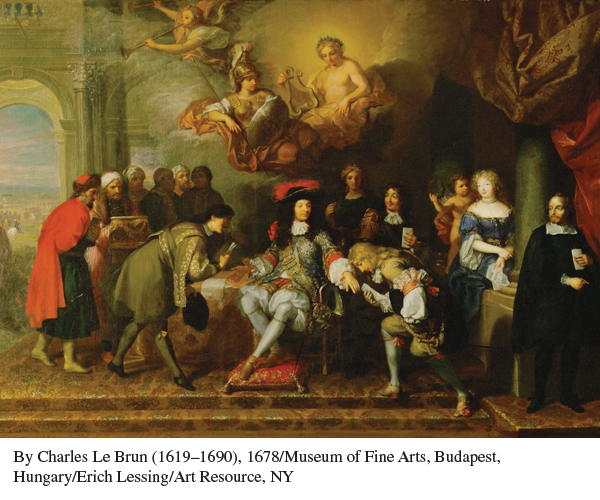A History of Western Society: Printed Page 464
A History of Western Society, Value Edition: Printed Page 448
A History of Western Society, Concise Edition: Printed Page 465
Introduction for Chapter 15
15
Absolutism and Constitutionalism
ca. 1589–1725
The seventeenth century was a period of crisis and transformation in Europe. Agricultural and manufacturing slumps led to food shortages and shrinking population rates. Religious and dynastic conflicts led to almost constant war, visiting violence and destruction on ordinary people and reshaping European states. With Louis XIV of France taking the lead, armies grew larger than they had been since the time of the Roman Empire, resulting in new government bureaucracies and higher taxes. Yet even with these obstacles, European states succeeded in gathering more power, and by 1680 much of the unrest that originated with the Reformation was resolved.
These crises were not limited to western Europe. Central and eastern Europe experienced even more catastrophic dislocation, with German lands serving as the battleground of the Thirty Years’ War and borders constantly vulnerable to attack from the east. In Prussia and in Habsburg Austria absolutist states emerged in the aftermath of this conflict. Russia and the Ottoman Turks also experienced turmoil in the mid-
While absolutism emerged as the solution to crisis in many European states, a small minority adopted a different path, placing sovereignty in the hands of privileged groups rather than the Crown. Historians refer to states where executive power was limited by law as “constitutional.” The two most important seventeenth-

CHAPTER PREVIEW
What were the common crises and achievements of seventeenth-
What factors led to the rise of the French absolutist state under Louis XIV, and why did absolutist Spain experience decline in the same period?
What were the social conditions of eastern Europe, and how did the rulers of Austria and Prussia transform their nations into powerful absolutist monarchies?
What were the distinctive features of Russian and Ottoman absolutism?
Why and how did the constitutional state triumph in the Dutch Republic and England?
Chronology
| ca. 1500–1650 | Consolidation of serfdom in eastern Europe |
| 1533–1584 | Reign of Ivan the Terrible in Russia |
| 1589–1610 | Reign of Henry IV in France |
| 1598–1613 | Time of Troubles in Russia |
| 1620–1740 | Growth of absolutism in Austria and Prussia |
| 1642–1649 | English civil war, which ends with execution of Charles I |
| 1643–1715 | Reign of Louis XIV in France |
| 1653–1658 | Military rule in England under Oliver Cromwell (the Protectorate) |
| 1660 | Restoration of English monarchy under Charles II |
| 1665–1683 | Jean- |
| 1670 | Charles II agrees to re- |
| 1670–1671 | Cossack revolt led by Stenka Razin |
| ca.1680–1750 | Construction of absolutist palaces |
| 1682 | Louis XIV moves court to Versailles |
| 1682–1725 | Reign of Peter the Great in Russia |
| 1683–1718 | Habsburgs push the Ottoman Turks from Hungary |
| 1685 | Edict of Nantes revoked in France |
| 1688–1689 | Glorious Revolution in England |
| 1701–1713 | War of the Spanish Succession |